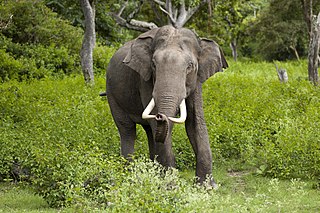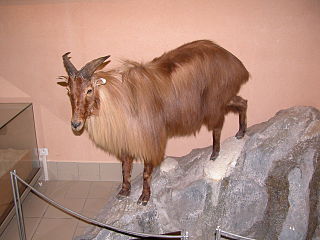
Proboscidea is a taxonomic order of afrotherian mammals containing one living family (Elephantidae) and several extinct families. First described by J. Illiger in 1811, it encompasses the elephants and their close relatives. From the mid-Miocene onwards, most proboscideans were very large. The largest land mammal of all time may have been a proboscidean; Palaeoloxodon namadicus was up to 5.2 m (17.1 ft) at the shoulder and may have weighed up to 22 t, almost double the weight of some sauropods like Diplodocus carnegii. The largest extant proboscidean is the African bush elephant, with a record of size of 4 m (13.1 ft) at the shoulder and 10.4 t. In addition to their enormous size, later proboscideans are distinguished by tusks and long, muscular trunks, which were less developed or absent in early proboscideans.

Elephantidae is a family of large, herbivorous proboscidean mammals collectively called elephants and mammoths. These are large terrestrial mammals with a snout modified into a trunk and teeth modified into tusks. Most genera and species in the family are extinct. Only two genera, Loxodonta and Elephas, are living.

Orycteropus is a genus of mammals in the family Orycteropodidae within Tubulidentata. The genus is known from Late Miocene to recent of Africa.
Australopithecus bahrelghazali is an extinct species of australopithecine discovered in 1995 at Koro Toro, Bahr el Gazel, Chad, existing around 3.5 million years ago in the Pliocene. It is the first and only australopithecine known from Central Africa, and demonstrates that this group was widely distributed across Africa as opposed to being restricted to East and southern Africa as previously thought. The validity of A. bahrelghazali has not been widely accepted, in favour of classifying the specimens as A. afarensis, a better known Pliocene australopithecine from East Africa, because of the anatomical similarity and the fact that A. bahrelghazali is known only from 3 partial jawbones and an isolated premolar. The specimens inhabited a lakeside grassland environment with sparse tree cover, possibly similar to the modern Okavango Delta, and similarly predominantly ate C4 savanna foods—such as grasses, sedges, storage organs, or rhizomes—and to a lesser degree also C3 forest foods—such as fruits, flowers, pods, or insects. However, the teeth seem ill-equipped to process C4 plants, so its true diet is unclear.

Anancus is an extinct genus of "tetralophodont gomphothere" native to Afro-Eurasia, that lived from the Tortonian stage of the late Miocene until its extinction during the Early Pleistocene, roughly from 8.5–2 million years ago.

Anthracobune is an extinct genus of stem perissodactyl from the middle Eocene of the Upper Kuldana Formation of Kohat, Punjab, Pakistan.
Paratetralophodon is an extinct genus of proboscidean from late Neogene deposits in India and China. Although traditionally classified in the family Gomphotheriidae, recent studies find it to be more closely related to modern elephants.
Aegyrcitherium is an extinct genus of prehistoric rhinoceros endemic to Europe during the Miocene living from 16.9—16 mya existing for approximately 0.9 million years.
This paleomammalogy list records new fossil mammal taxa that were described during the year 2012, as well as notes other significant paleomammalogy discoveries and events which occurred during that year.

Stegodibelodon is an extinct genus primitive elephantid known from the Early Pliocene of Africa. It is known only from the Djourab region of northern Chad, where it was discovered by Franco-Chadian expeditions. It differs from the most primitive elephantid Stegotetrabelodon by the absence of lower tusks and a shortened mandibular symphysis, and the more pronounced nature of the lamellae on the molars, with each molar possessing at least seven lamellae, though the number of lamellae is low compared to modern elephant teeth, and the teeth are also low crowned (brachydont) relative to modern elephants.
This paleomammalogy list records new fossil mammal taxa that were described during the year 2014, as well as notes other significant paleomammalogy discoveries and events which occurred during that year.
The Conglomérat de Cernay is a geologic formation in Champagne-Ardenne, northern France. It preserves fossils dating back to the Thanetian stage of the Paleocene period. The lizard Cernaycerta and placental mammal Bustylus cernaysi are named after the formation.
This paleomammalogy list records new fossil mammal taxa that were described during the year 2011, as well as notes other significant paleomammalogy discoveries and events which occurred during that year.
This paleomammalogy list records new fossil mammal taxa that were described during the year 2010, as well as notes other significant paleomammalogy discoveries and events which occurred during that year.
This paleomammalogy list records new fossil mammal taxa that were described during the year 2009, as well as notes other significant paleomammalogy discoveries and events which occurred during that year.

Eozygodon is an extinct genus of proboscidean in the family Mammutidae that is based on a single species, E. morotoensis, named in 1983. It is known from the Early Miocene of Africa and well as possibly the Middle Miocene of China. It is considered a primitive member of the family, retaining a long lower jaw (longirostrine) with lower tusks. The upper tusks are small and are parallel to each other. The body mass is considerably smaller than the American mastodon. Dental mesowear from East African specimens suggests a browsing diet.
Amphiorycteropus is an extinct genus of mammals in the family Orycteropodidae within Tubulidentata. The genus is known from fossils dating from Middle Miocene to Early Pliocene, found in Africa, Asia and Europe.

Serengetilagus is a genus of lagomorph in the family Leporidae. It lived in the Pliocene of Kenya and Tanzania and the Late Miocene of Chad. Serengetilagus is the best-represented taxon from Laetoli, with approximately 34 percent of fossils in the Laetolil Beds attributed to this genus. Additional specimens from Angola, Morocco and Ukraine may also belong to this genus. It had a number of specific features unknown in other lagomorphs, such as a "missing" mesoflexid on its third premolar.

Hemitragus bonali, the Bonal tahr, is an extinct species of bovid from the Pleistocene of Europe and the Caucasus mountains region.











